German Plum Cake (Zwetschgenkuchen)
This post may contain affiliate links. See my disclosure policy.
This authentic German Plum Cake recipe, known as Zwetschgenkuchen or Zwetschgendatschi, is made just the way you know and love it from Germany! A yeast-based cake with juicy plums and a sweet streusel topping, this extraordinarily delicious cake is one of my very favorites and is the way my Mutti and Oma made it!
For more fruity German cakes be sure to also try our German Apple Cake, Rhubarb Streusel Cake, and while not exactly “cake,” our Apple Strudel is a must!
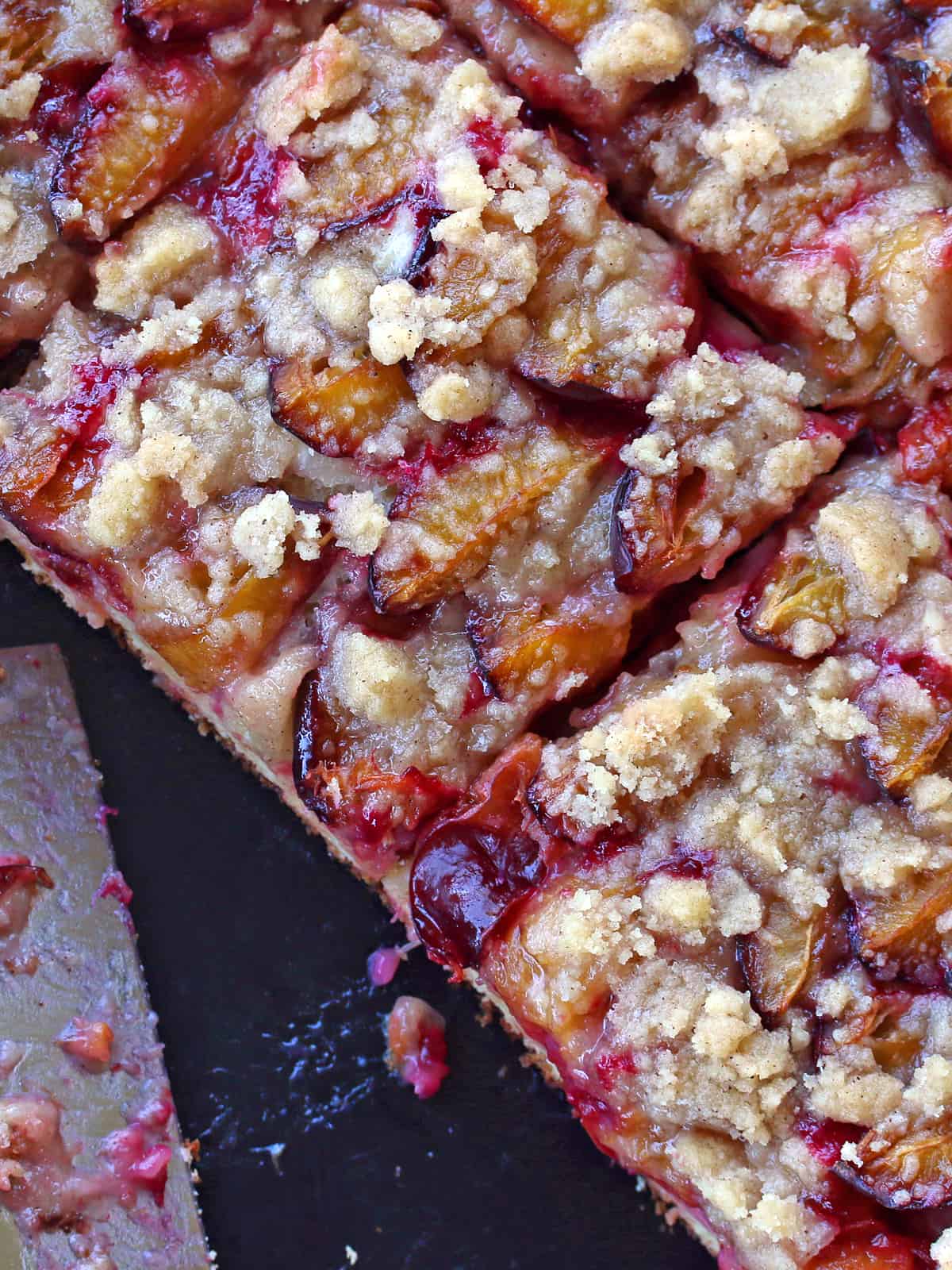
Depending on which region of Germany you’re in, German plum cake goes by a variety of names including Zwetschgenkuchen, Zwetschgendatschi, Quetschekuche or Pflaumenkuchen. I know, they’re all tongue-twisters! :)
Variations exist throughout the regions of Germany with some versions using a yeast dough while others use a shortcrust pastry known as Rührteig. Some have a streusel topping while others omit it. And some people make them round and taller while others make them rectangular in the style known as “Blechkuchen” (sheet pan cake). But whichever pastry crust is used, with or without streusel, and whether it’s round or rectangular, all of these versions showcase the plump, juicy, sweet European plums known as Italian plums.

Which Plums Do I Need to Make German Plum Cake?
To make proper German plum cake you really need Italian plums. These are small and oval-shaped and are far meatier than their Asian plum cousins. Fleshier with a lower moisture content is important because you want to have a moist cake, not a mushy cake. Italian plums are considered the most ideal for cooking and baking not only because of their texture but also because their flavor becomes more complex and delicious through cooking. Italian plum season is short, usually from September through early October, and Germans know how to seize the opportunity when it’s there. So wait patiently for plum season and then hit your local farmer’s markets for some Italian plums. Alternatively you can also use frozen Italian plums; just be sure to thaw and very thoroughly drain them before using them.
We were so lucky to have our own Italian plum trees when we lived in Washington State. When we moved to Virginia a few years ago we immediately got to work planting an orchard of fruit trees, including some Italian plums. They’re not yielding a lot of fruit yet, but they’re getting there and I’ll be ready for them!
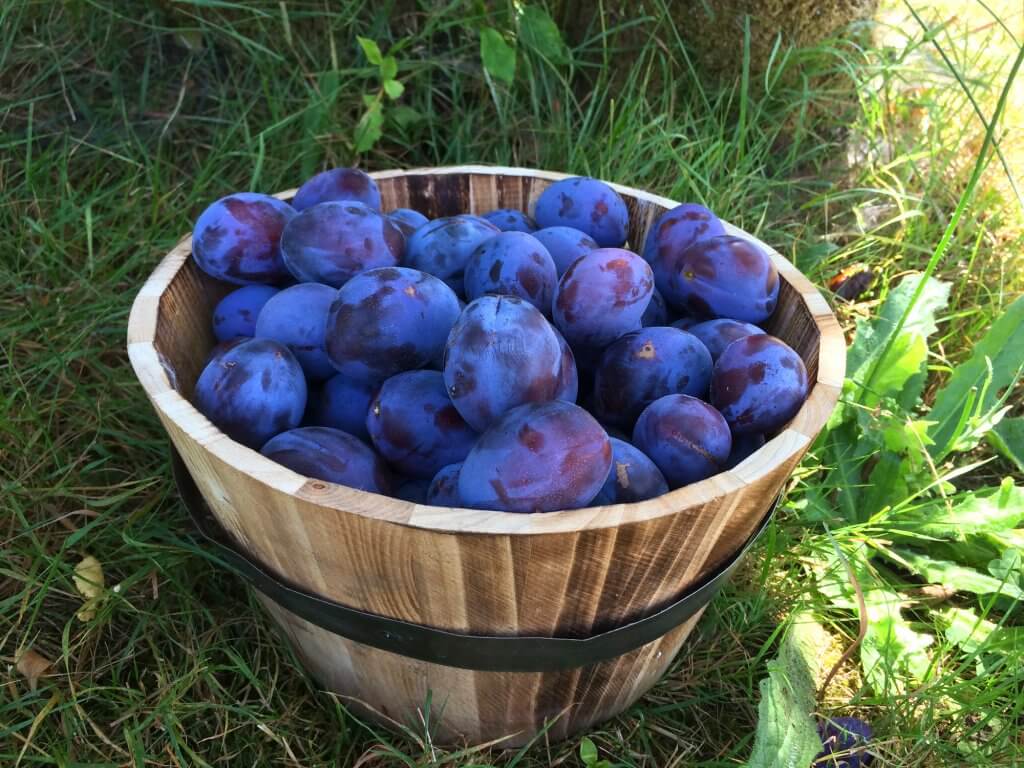
The version of German Plum Cake that we’re making today is my personal favorite. It’s made with yeast dough, which is more time-consuming than the simpler Rührteig (shortcrust pastry) versions, but it’s far superior in my opinion. This traditional version is also sprinkled with a streusel topping. This Zwetschgenkuchen recipe is the way my Mutti and Oma made it and is typical of where I’m from in Baden-Württemberg, though this version is popular throughout Germany. This type of Zwetschgenkuchen is typically made on a Backblech (a baking sheet) versus in a round springform and cut into squares for serving.
Like most German cakes, this German plum cake is not overly sweet. It has a nice balance between sweet and tart with just a touch of warmth from the cinnamon. The riper the plums the sweeter the cake will be.
This German plum cake will keep for 2-3 days. And although the streusel will get soft, the cake tastes even better the day after baking as the juices from the plums have time to penetrate the dough.
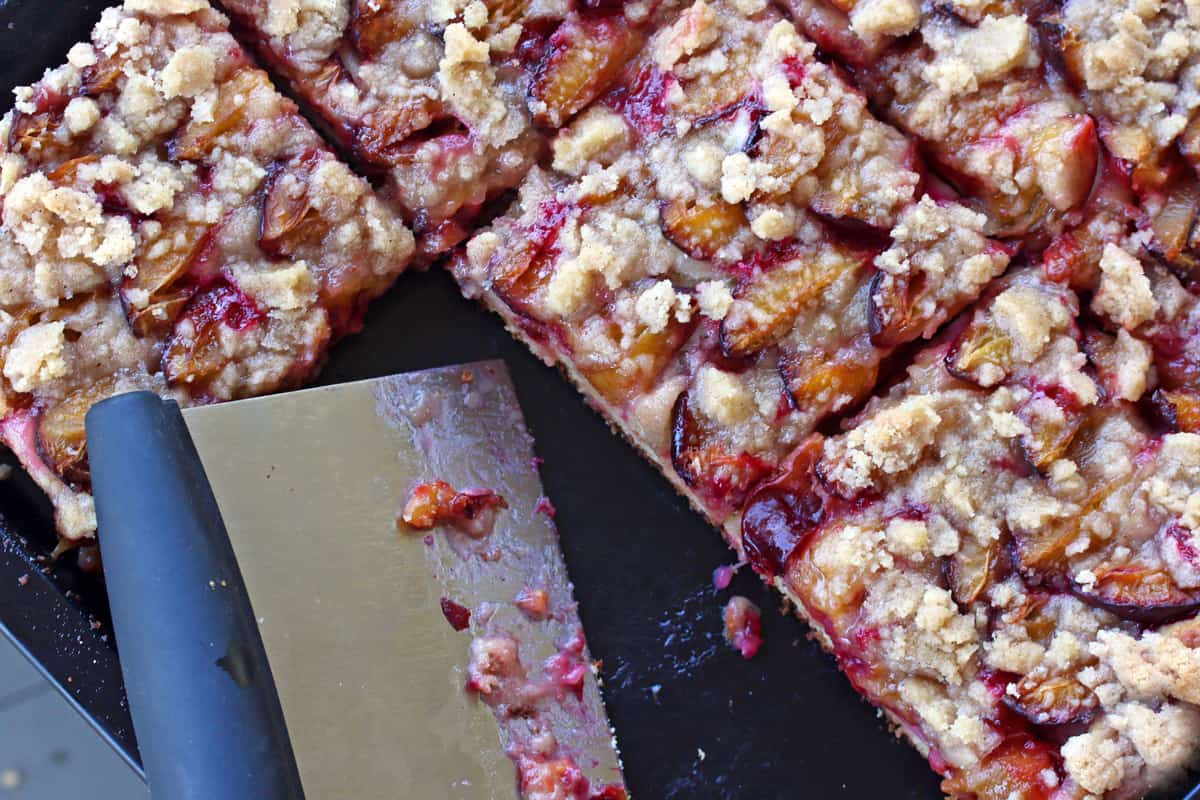
Can I Use Other Fruits?
You sure can! This recipe is also delicious using other stone fruits like apricots, peaches and nectarines.
Can You Freeze German Plum Cake?
Yes, you can. I generally recommend eating it within a couple of days but if you have more leftovers than you can manage, this can be wrapped and put in a freezer container for up to a month. Let it thaw in the fridge overnight.
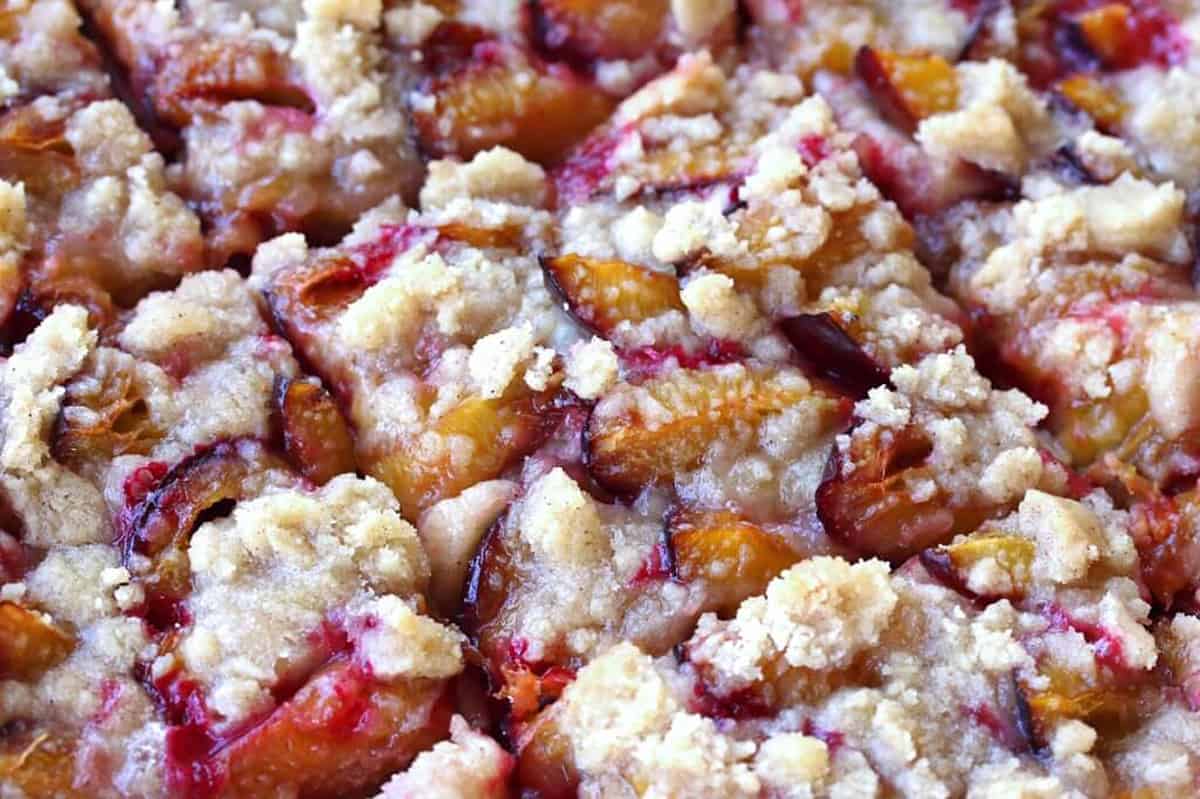
German Plum Cake Recipe
Let’s get started!
Dissolve the yeast into the warm milk and let is sit for 5-10 minutes until frothy.
Place the flour, sugar and salt in the bowl of a stand mixer and pour in the yeast mixture, melted warm (not hot) butter, eggs and vanilla extract. Give it an initial stir to combine the ingredients and then attach a dough hook and knead it on the bread setting (“2”) for 4-5 minutes.
The dough will be sticky but should hold together fairly well. It will not be firm enough to knead into a ball, think of it more as a thick batter.
Cover it loosely with plastic wrap and set it in a warm, draft free place to rise for an hour or until about doubled in size.
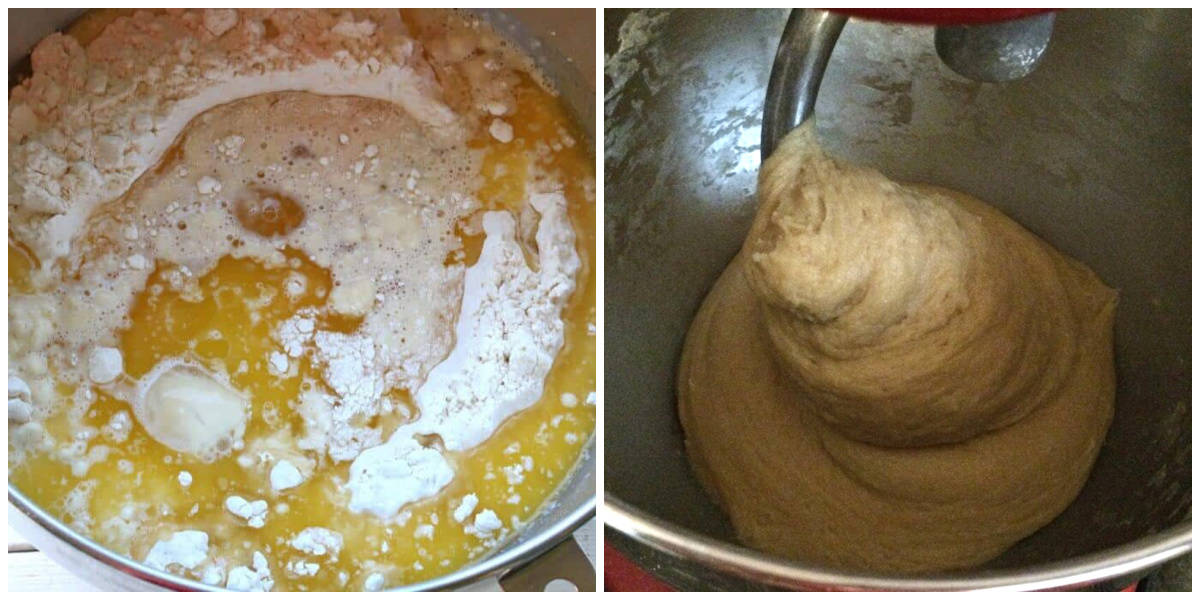
Generously butter a large jelly roll pan (at least 18 inches in length and about 13 inches wide) or, like I’m using and as pictured below, a German Backblech if you have one (the one I’m using in the picture I brought with me from Germany).
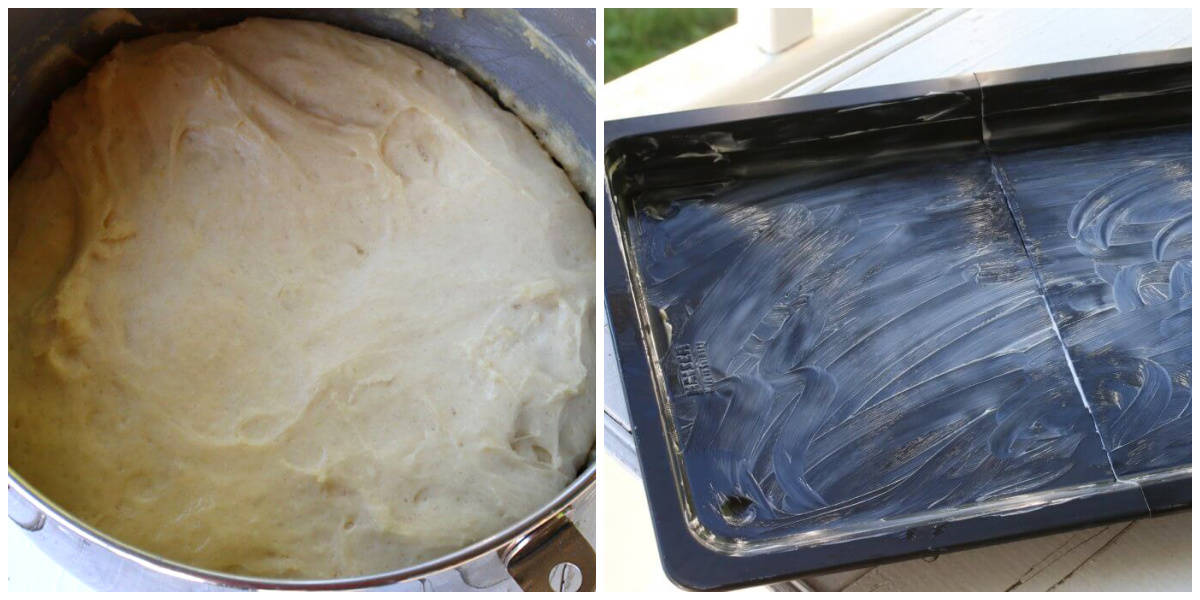
Use your hands to spread the dough out across the full length of the pan, pressing it up against the sides. It’s yeast dough so it will resist, but just keep pushing it back into position the best you can. Once you put the plums on it, those will help keep it in place.
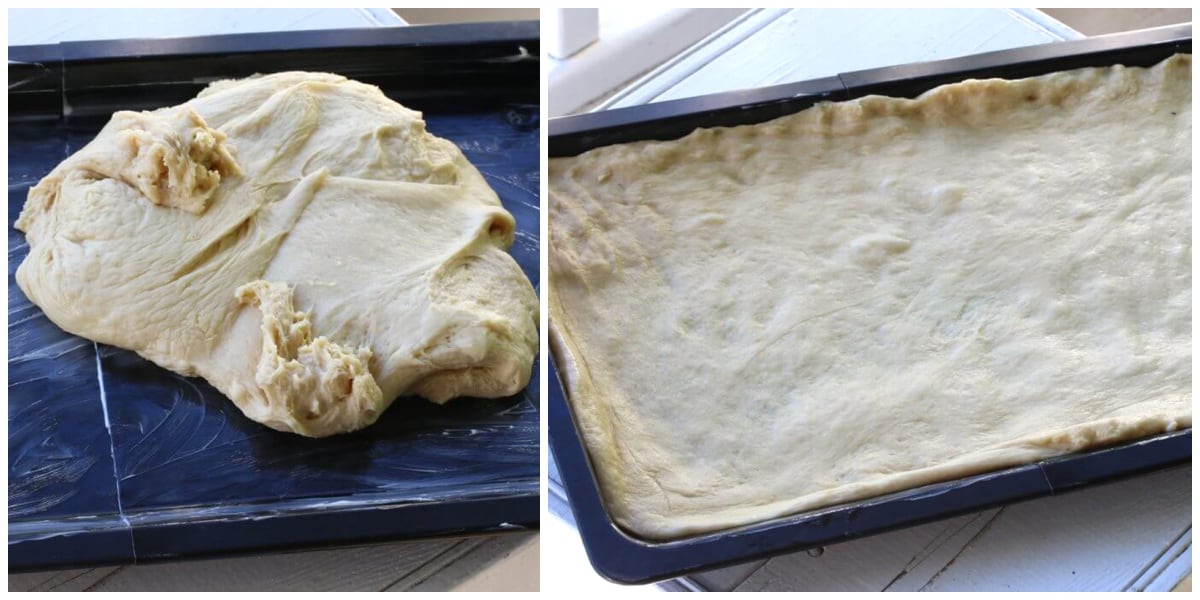
Time for the plums! The riper the plums the sweeter the cake will be. However, if they’re overly ripe – meaning mushy – they’ll be even mushier on the finished baked product, so keep that in mind too.
Cut the plums in half and remove the pits. Then slice the plums in half again, slicing each plum into quarters.
Lay the plums close together in rows over the whole length of the dough on the sheet pan.
If you want your cake a bit sweeter you can sprinkle it *lightly* with sugar or cinnamon-sugar if you prefer more cinnamon. I emphasize “lightly” because the more sugar you add the more watery the cake will be as the sugar liquifies during baking and your streusel will also “melt” in contact with it.
Set the pan in a warm place and let it rise for up to another hour.
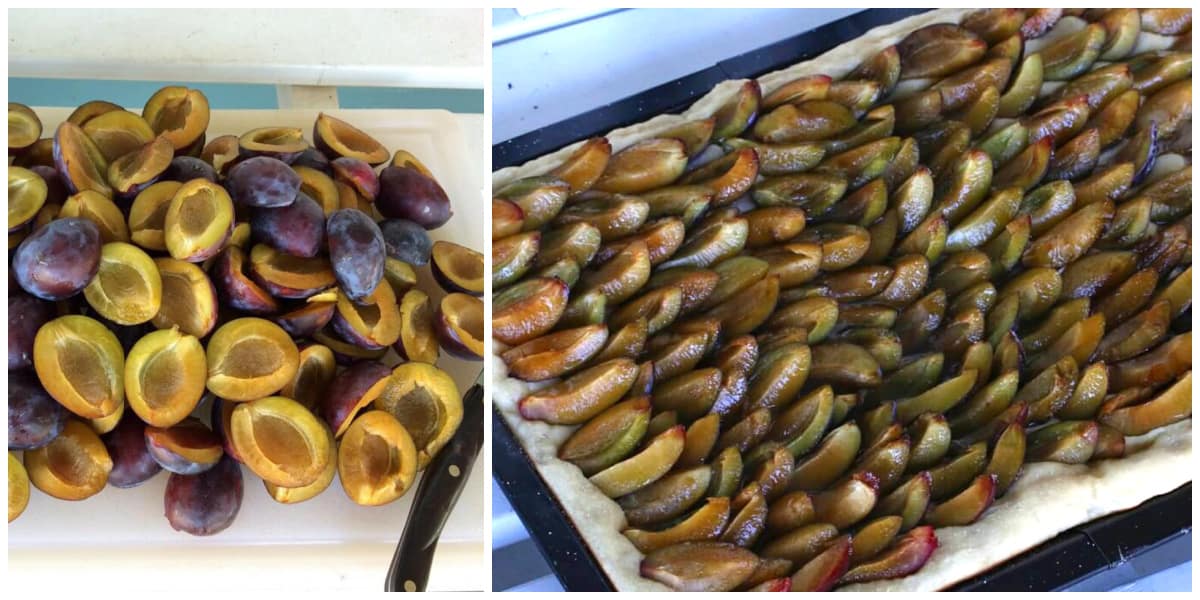
Now let’s make the streusel topping. Place all the ingredients in a medium-sized bowl and use your fingers to bring it all together. Work with the mixture until it’s thoroughly combined and forms a rough sand and clumpy texture.
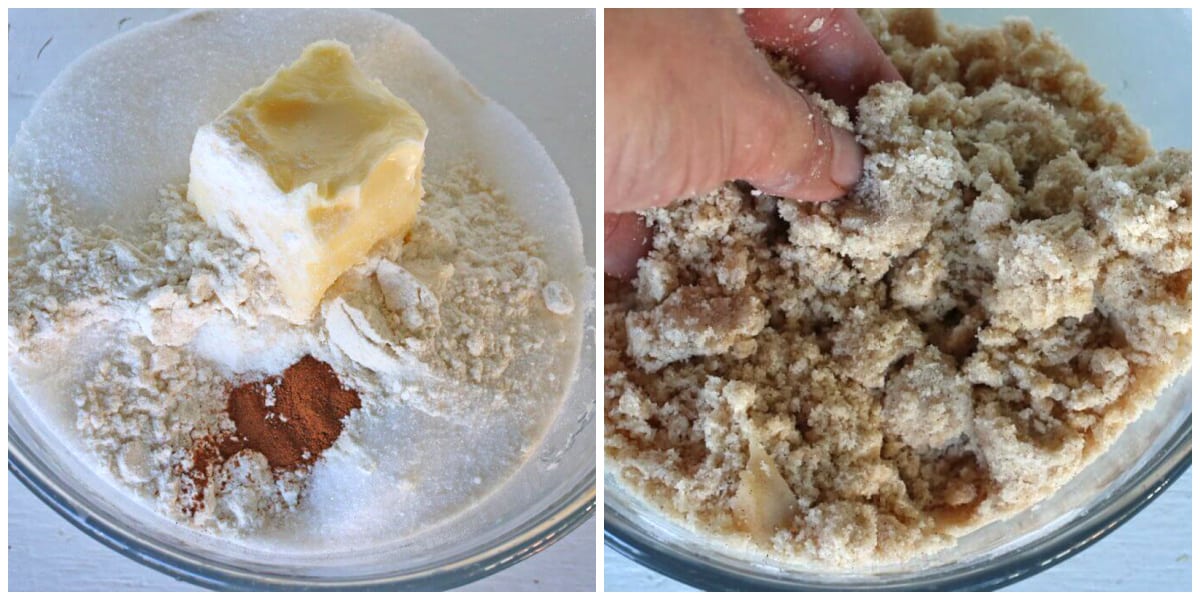
Sprinkle the streusel over the top of the cake.
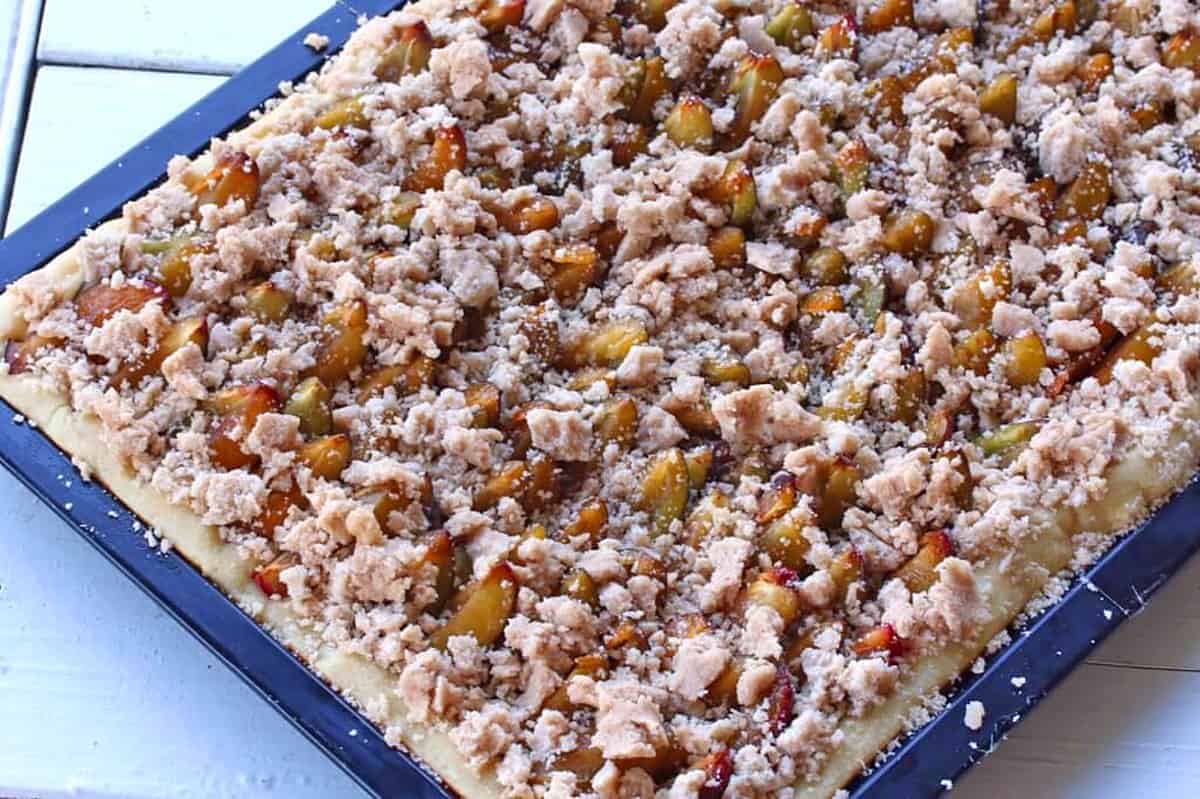
Bake the cake on the middle rack of the oven preheated to 350 degrees for 30-35 minutes or until the top is golden.
Let the cake sit for at least 10 minutes before slicing to let some of the liquid set.

Slice the cake into squares.
A tool that I use that’s really handy and works like a charm for sheet cakes and many other things is the OXO Multi-Purpose Scraper & Chopper.
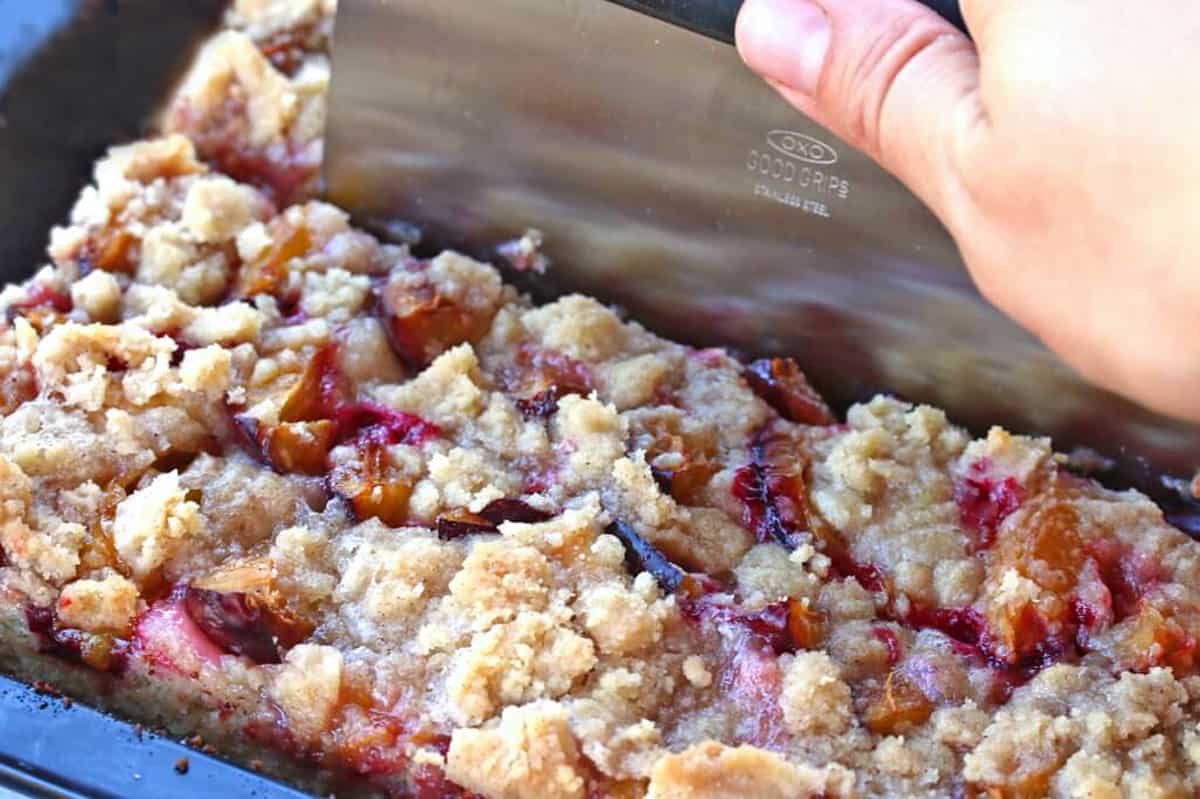
Serve and enjoy!
Guten Appetit!

For more delicious German desserts be sure to try our:
- German Apple Cake
- German Cheesecake
- Berliner
- Dampfnudeln
- Germknödel
- Cherry Marzipan Streusel Cake
- Gugelhupf
- Stollen
- Rhubarb Streusel Cake
- Pfeffernüsse
- Lebkuchen
- Zimtsterne
Save This Recipe
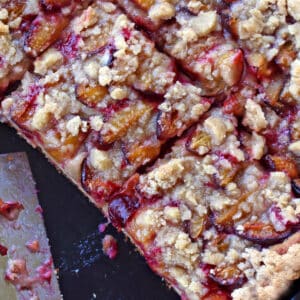
German Plum Cake (Zwetschgenkuchen)
Ingredients
- 3 + pounds Italian plums ,cut into quarters, pits removed
- 1 cup warm milk , *start with 3/4 and add extra to the dough as needed
- 1 1/2 tablespoons dry active yeast
- 4 cups all-purpose flour
- 3/4 cup sugar
- 1/2 teaspoon salt
- 1 stick butter (1/2 cup melted but not hot)
- 2 eggs
- 1 teaspoon quality pure vanilla extract
- For the Streusel:
- 1 cup all-purpose flour
- 1 cup sugar
- 1 teaspoon ground cinnamon
- 1/2 cup butter ,at room temperature
Instructions
- Dissolve the yeast into the 3/4 cup warm milk and let is sit for 5-10 minutes until frothy.
- Place the flour, sugar and salt in the bowl of a stand mixer and pour in the yeast mixture, melted warm (not hot) butter, eggs and vanilla extract. Give it an initial stir to combine the ingredients and then attach a dough hook and knead it on the bread setting ("2") for 4-5 minutes, adding the remaining 1/4 cup milk as necessary. (The dough will be sticky but should hold together fairly well. It will not be firm enough to knead into a ball, think of it more as a thick batter.) Cover it loosely with plastic wrap and set it in a warm, draft free place to rise for an hour or until about doubled in size.
- Generously butter a German Backblech extended to full length or a large jelly roll pan (at least 18 inches in length and 1 inch sides but even then the crust will be thicker than with the Backblech).
- Use your hands to spread the dough out across the full length of the pan, pressing it up against the sides. (It's yeast dough so it will resist, but just keep pushing it back into position the best you can. Once you put the plums on it, those will help keep it in place.) Lay the plums close together in rows over the whole length of the dough on the sheet pan. (If you want your cake a bit sweeter you can sprinkle it *lightly* with sugar or cinnamon-sugar if you prefer more cinnamon. I emphasize "lightly" because the more sugar you add the more watery the cake will be as the sugar liquifies during baking and your streusel will also "melt" in contact with it.)
- Set the pan in a warm place and let it rise for up to another hour.
- To make the streusel: Place all the ingredients in a medium-sized bowl and use your fingers to bring it all together. Work with the mixture until it's thoroughly combined and forms a rough sand and clumpy texture. Sprinkle the streusel over the top of the cake.
- Bake the cake on the middle rack of the oven preheated to 350 degrees for 30-35 minutes or until the top is golden.
- Let the cake sit for at least 10 minutes before slicing to let some of the liquid set. Slice the cake into squares and serve.
Notes
Nutrition
Originally published on The Daring Gourmet September 8, 2016



















It is 10:30 pm on a Saturday night and my whole house smells like heaven! I have two of these cakes in the oven for the last 5 minutes and couldn’t help myself so I took one out and cut the smallest square from the corner. My daughter, husband, and I couldn’t wait to taste it. OH my gosh you have just made everyone in my house so happy!! My kids were born in Germany. We are a military family and have made at least 10 moves in their lives. The oldest is 21! Every place that we have lived is tied to a food and this cake is Germany. My two boys (17 &18 yrs) are celiacs so I had to tweak the flours a bit. It was so worth it! I made one large cookie sheet and a half cookie sheet. Ill be lucky if there is any left for breakfast. Thank you so much for the recipe and the excitement for one of the yummiest memories of Germany!!
I would love to rate this a perfect 10!! <3<3<3
YES!!! I’m absolutely delighted to hear it’s been such a family hit, Lysa, thank you so much for the feedback! <3
I wish I could find those certain plums anywhere. I found some called French plums today at the farmers market. The taste is just like the german plums, but the are much smaller. It’ll have to do. Making zwetschken kuchen tomorrow 😍😍😍, can’t wait!
Yay, Petra! Let us know how it goes!
Came out delicious
Wonderful, thank you!
Hi Kimberly, just went to the German Fest in Huntington Beach California, of course had to have the Zwetschgunkuchen, delicious. I bought one slice that was made with the yeast dough then I bought one a whole one at the bakery that was made with a butter crust, both delicious but I’m all about tradition so I’m making yours. I have one question about the backblech, usually when a baking pan is dark it has a tendency to overbake things, do you lower the temp in your oven to accommodate this? I like how it is expandable. Just to let your readers know Costco wholesale sells the plums when they are in season. I’m going to buy some today and try your recipe.
Thank you for posting!
Hi Trudy, yes, it can have a tendency to overbake the bottom of the cake and so you’ll want to make sure you bake it on the middle shelf, not the bottom. Even so, expect a light brown crust. I also check it a couple of times a few minutes early to check for doneness. Thanks for the tip on the Costco plums and happy baking! :)
As a young girl, going to German School in the 60’s in San Francisco to keep up with the language, I loved eating this plum kuchen at the various celebration and events. Your photos look exactly as I remembered it. I love yeast cakes and breads and this one is no exception. I will make it tomorrow with my Satsuma plums which are a bit juicier than the recipe sites. Thanks for posting this recipe!
Wonderful, Lorna, let us know what you think and if this cake is how you remember it!
I just wanted to thank you for posting this recipe. I used to buy a piece of this delicious cake every weekend from a German baker who had a stall at our local farmers market. I have since moved to another town, so I searched on the Internet for quite a while to find a recipe so I could make it myself, and finally stumbled across your recipe. Made it last weekend and it looked, smelt and tasted exactly the same as the one I used to buy, it turned out perfect! And it was really easy to make as well. Will try another one of your recipes next weekend!
YES!! I’m so thrilled to hear that, Emma, thank you!
This was one of my favorite cakes growing up. However, instead of streusel my Oma used something she call einbrein. Have you heard about that? I would like to find a recipe for that topping. It was more like a sauce that hardened upon baking. Any idea where I could look for that recipe?
Hi Sue, do you mean Einbrenn? Einbrenn is a roux, so it’s made by melting butter and adding an equal amount of flour, whisking it until it’s golden, then pouring in milk and continuing to whisk until it’s a creamy mixture. It’s what’s used to thicken sauces and I’ve never heard of it being used as a topping for cake. Another common topping for Zwetschgenkuchen is a layer of vanilla custard that firms up when it’s baked, but it isn’t called Einbrenn, einbrein, or anything similar to that.
Yes,it was a type of roux. She would sprinkle the sugar over the plums and then pour the sauce over the cake. Maybe it was designed to absorb the juice from the plums. Oma was German born in Serbia. I don’t think milk was very plentiful. All of her sauces were made with water instead of milk so butter for streusel may not have been available. Thank you for your reply, Kimberly!
My mother made this cake a few times – i can remember the yeast aroma and the tangy smell of the plums as if it was yesterday (actualy 40 plus years ago)
So true, Oliver. They’ve found that smell is more closely linked to memory than any of the other five senses and I believe it.
I’m being looking for good recipe for German plum cake Zwetschgenkuchen and I finally found on your website This cake looks delicious and I making this weakend I have my friends from Germany ( visiting) so I will surprise them and they can be a critics how it turns out. Because the Italian plum season is short I was wondering if I made couple of cakes and freezes some for lather use its the cake still by OK? I think if I pre-cook maybe halfway then cool wrapped in ceramics wrap and freeze then when I needed cook from frozen till done or I should freeze before cooking? Anyone have any suggestions? Please let my know! Loreta
Hi Loreta, I’m so glad you found my site – welcome! I’m sure your friends will be very impressed :) If you bake it completely and then cool it, it should freeze pretty well, except that the streusel will lose its crunch. If your plums can hold out until your friends arrive I would suggest waiting. Storing the plums in the crisper drawer in the fridge will prolong their life. Let us know how it goes!